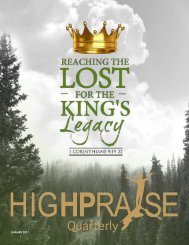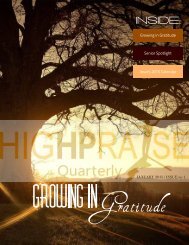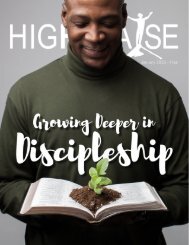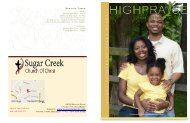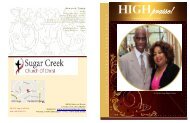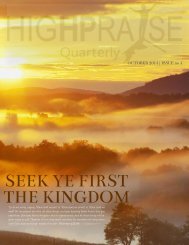You also want an ePaper? Increase the reach of your titles
YUMPU automatically turns print PDFs into web optimized ePapers that Google loves.
Hyperbole, perhaps. Still, during the six years preceding 1800, the Methodist <strong>Church</strong>—most<br />
popular among the expanding middle and lower classes—declined in national membership<br />
from 67,643 to 61,351. In the 1790s the population of frontier Kentucky tripled, but the<br />
already meager Methodist membership decreased.<br />
<strong>Church</strong>es and pastors did not merely wring their hands; they clasped them in prayer—at<br />
prayer meetings, at worship, and at national conventions. In 1798 the Presbyterian General<br />
Assembly asked that a day be set aside for fasting, humiliation, and prayer to redeem the<br />
frontier from “Egyptian darkness.”<br />
<strong>Church</strong> discipline was thrown into high gear. <strong>Church</strong> minute books record those excluded<br />
from fellowship for alcoholism, profanity, mistreatment of slaves, and sexual immorality. Some<br />
congregations were so exacting, they decimated their ranks. No matter, they said; sinning<br />
had to be stopped in order that God might again bless.<br />
In the years leading up to Cane Ridge, Methodist and Baptist churches were having small<br />
revivals, but the largest crowds were gathering for Presbyterian communion services, which<br />
were part of a centuries-old tradition, imported by Scottish immigrants, that combined<br />
intense religious services with social gatherings.<br />
The Leaders of the Movement<br />
Barton Stone was a Presbyterian minister but always struggled with the “Calvinist” doctrines<br />
of election, reprobation, and predestination. He began to question doctrines like these and<br />
also the doctrine of the trinity. Before his ordination and call to a church in Cane Ridge,<br />
Kentucky, Stone wrote, “I stumbled at the doctrine of the Trinity as taught in the Westminster<br />
Confession. I labored to believe it, but could not consciously subscribe to it.<br />
A few years after Stone’s movement began, another Presbyterian minister, Thomas Campbell,<br />
left his native Ireland and came to America. He was assigned a pastorate in western<br />
Pennsylvania. Campbell, also tired of denominational squabbles and isolation, began to<br />
preach for and cooperate with Christians. He was soon joined by his son, Alexander, who<br />
quickly became a fruitful itinerant preacher in Kentucky, Tennessee, and Virginia.<br />
In 1809 Thomas Campbell wrote a manifesto called “Declaration and Address” which was a<br />
commitment to self-reliance and the Bible alone, and not “human opinions.”6 Its major<br />
presupposition was that the churches have been divided into different parties by “speculative<br />
doctrines and human traditions not authorized by the New Testament.”<br />
One of the divisive issues, then and now, was the meaning, mode, and subjects of baptism.<br />
Believing that their previous infant all baptism was in error, the Campbells were rebaptized by<br />
immersion in 1812 by Baptist pastor Matthias Luce.<br />
The Campbells met and discussed doctrine with Barton Stone in 1824. They found they had<br />
much in common. In fact, they held the same view on most points of belief and practice. So,<br />
in 1831 the majority of Stone’s followers merged with the Campbellites.








